Great Lakes Brown Trout Fishing: An In-Depth Guide
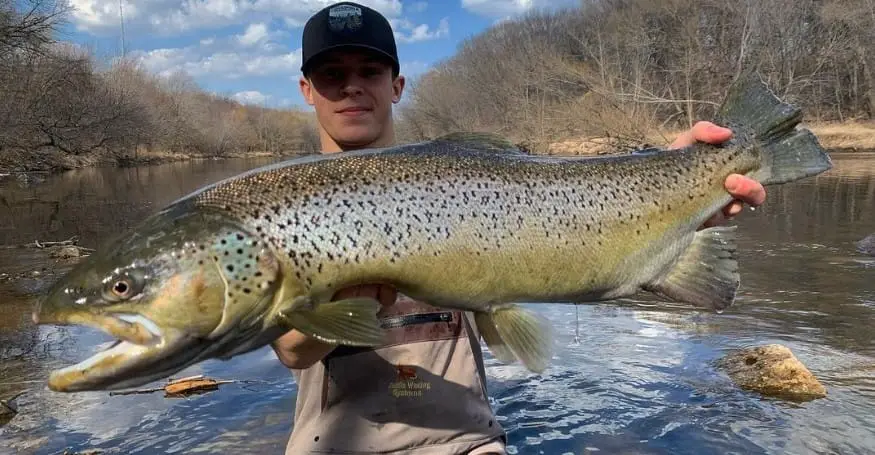
The Great Lakes region has some of the best salmon and steelhead fishing in the world, but did you know the Great Lakes brown trout fishing can be fantastic with trophy-sized brown trout over 20 pounds?
Great lakes brown trout are migratory brown trout that are born in the rivers, they migrate to the lake where they gorge and grow very big, and then they return to rivers as adults to spawn in the fall. An average sized spawning brown trout is 4 to 8 pounds.
I’ll cover all the methods I use a fishing guide to used to catch these trophy-sized fish, as well as my best baits and lures, and discuss where and when it’s best to target these massive brown trout.
Great Lakes Brown Trout
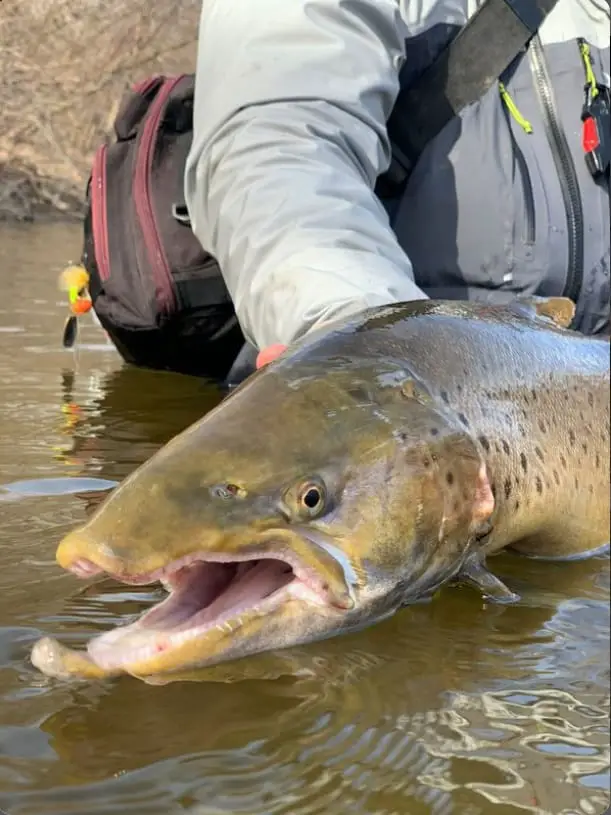
They are also known as lake-run brown trout or migratory brown trout.
They have the ability to grow over 40 pounds.
The explosive growth and size are due to the fact they spend most of the year out in the lake feeding on baitfish.
The original migratory brown trout stocked back in 1979 in New York was a species of brown trout known as the Seeforellen German Brown trout.
This species is known for its huge appetite and since it can live 12 to 15 years, enables it to reach true trophy sizes of over 40 pounds.
An average lake-run brown trout is 4 to 8 pounds, with many between 10 and 20 pounds caught both in the lake and the rivers every year.
The current world record brown trout came from a Michigan river at it was 41 lbs 7 ounces.
Which Great Lakes Have Migratory Brown Trout?
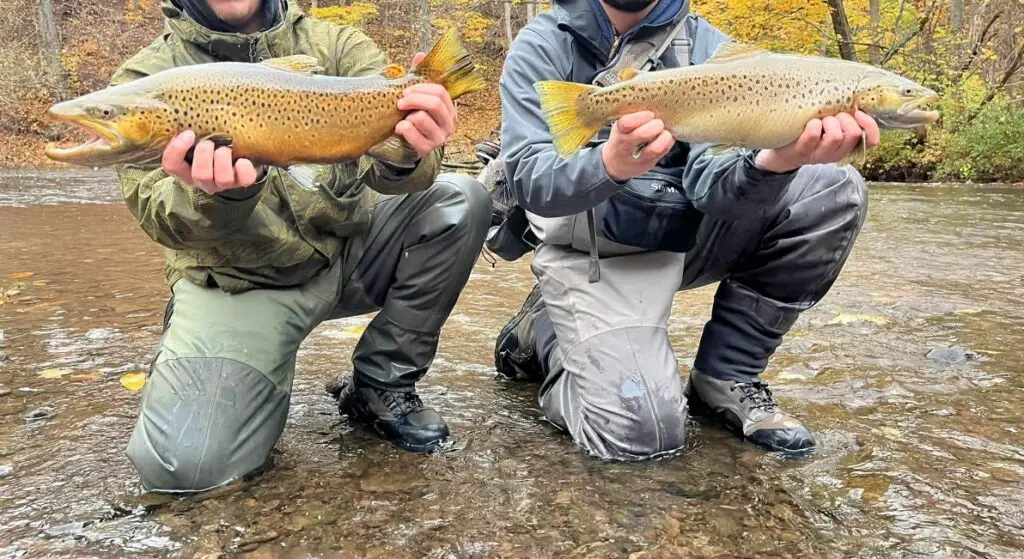
All the Great Lakes have these migratory brown trout to some extent.
Some states stock more brown trout than others which can create larger numbers than other areas. Some states also have better rivers with more potential for natural reproduction.
Is There Brown Trout In Lake Ontario: And Is The Fishing Good?
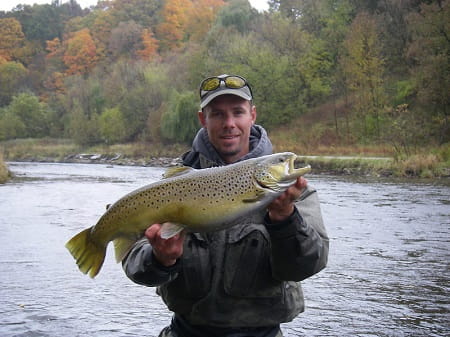
The south shore of Lake Ontario has some of the best lake brown trout fishing found anywhere around the Great Lakes, thanks to heavy stocking from New York state.
The north shore also has some brown trout fishing due to stocking from Ontario, Canada, and from strays from the US side.
It’s not uncommon to catch huge brown trout while fishing the best NY steelhead Rivers.
Ontario, Canada, also has some good rivers that have a higher percentage of natural reproduction and better survival rates for the young brown trout, which also improves the brown trout populations in the lake.
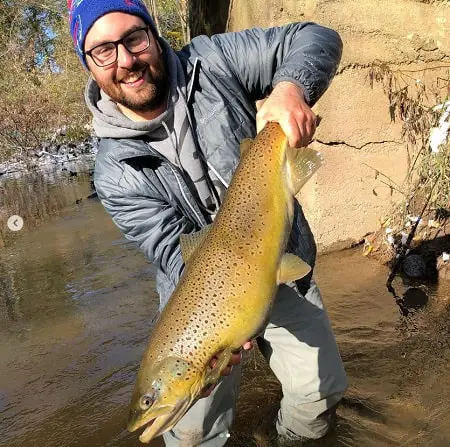
Reports have it that many of the states have used Ontario’s Ganaraska River Strain Brown trout in their stocking programs.
The New York side of Lake Ontario can be fantastic for fishing for lake run browns from September to May.
These New York stocked brown trout will roam all of Lake Ontario, providing good fishing for both US and Canadian anglers.
Is There Brown Trout In Lake Michigan? And Is The Fishing Good?
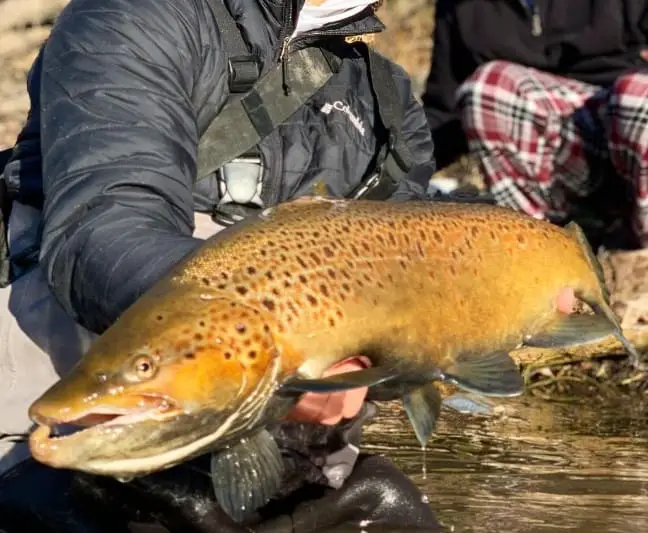
Lake Michigan is stocked by Michigan State and Wisconsin State which makes the lake a hotspot for lake run browns.
These two great stocking programs are supplemented by some great rivers that provide good natural reproduction.
This equates to some great brown trout fishing in the many tributaries of Lake Michigan. Most of the best Michigan steelhead rivers have good runs of Great Lakes browns.
Although there are good numbers, there are also a lot of rivers to fish and some will have low fishing pressure for anger that are willing to walk and explore.
Lake Michigan is also known to have some of the biggest brown trout thanks to plenty of forage in the lake. The record 41.7-pound brown trout was a Lake Michigan fish caught in the Manistee River in the fall of 2009.
Both Lakes Michigan and Lake Ontario are the two best lakes for a migratory brown trout fishing trip.
Is There Brown Trout In Lake Erie? And Is It Good?
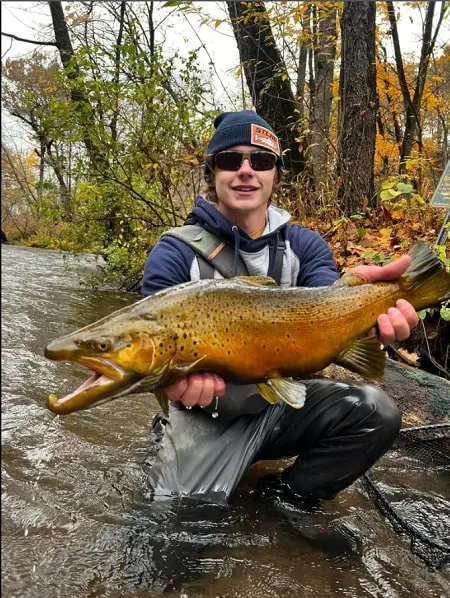
Although not found in huge numbers, Lake Erie anglers will be able to catch lake-run brown trout in Lake Erie and the Lake Erie tributaries.
A combination of lower numbers of stocked browns and less natural reproduction in the rivers means the Lake Erie brown trout fishery is not as good as Lake Ontario and Lake Michigan tributaries.
Also, Lake Erie brown trout are often overshadowed by the fantastic Pennsylvania steelhead fishing and the great Ohio Steelhead fishing.
Is There Brown Trout In Lake Superior? And Is It Good?
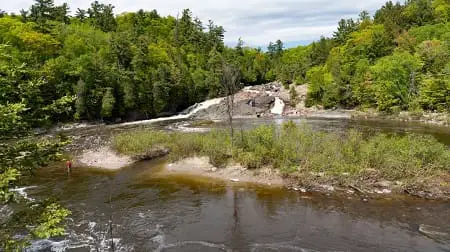
According to my sources, every year, thousands of migratory brown trout are stocked into Lake Superior to maintain a healthy population of lake-run brown trout for anglers.
Both lake and river fishing can be good.
Through a collaborative effort between the Michigan Department of Natural Resources (MDNR) and the Great Lakes Fishery Commission, over 2 million brown trout juveniles have been stocked in Lake Superior since 1982.
This stocking provides angling opportunities for lake and river anglers living in Michigan, Wisconsin, Minnesota, and Ontario.
Is There Brown Trout In Lake Huron? And Is It Good?
Lake Huron was once considered a great brown trout fishery thanks to heavy stocking on both the Michigan and Canadian side of the lake.
Unfortunately, due to the VHS virus about 10 years ago, which wiped out a high percentage of the baitfish in the lake, stocking efforts were cut below 50%.
There are still lake-run browns in the lake and they seem to be making a bit of a comeback, partially due to stocking and due to healthy rivers on both sides of the lake, which provide decent natural reproduction.
Prefered Brown Trout Temperature
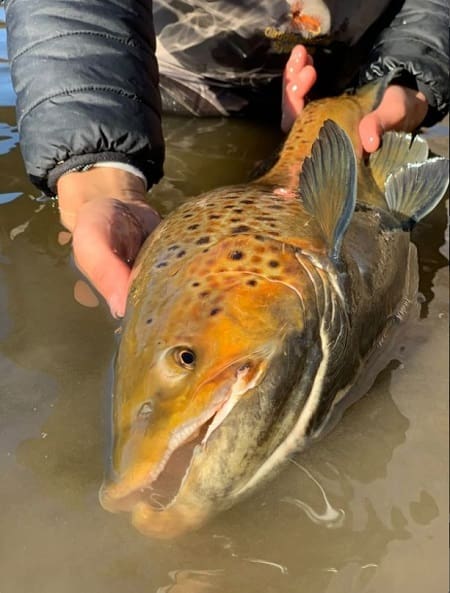
Lake run browns prefer 58 to 63 degrees both when in the rivers and in the Great Lakes.
However, they will feed and can be caught up to 67f or in much colder water temperatures around 37f to 40f.
Due to the extreme temperature variances, brown trout will feed in, anglers might see brown trout return to the rivers in early September, and stay in the rivers all winter.
I will discuss winter fishing for migratory browns below.
Brown trout in the lake can be eating machines, and they have a wide temperature tolerance and a diverse diet which enables them to feed on schools of baitfish out in the deep open water, or they can be found in near-shore waters cruising the shorelines and harbors of the Great Lakes for anything that swims.
They can do quite well feeding in 62 to 65-degree water, which is too warm for salmon and steelhead.
When Do Lake Run Browns Spawn?
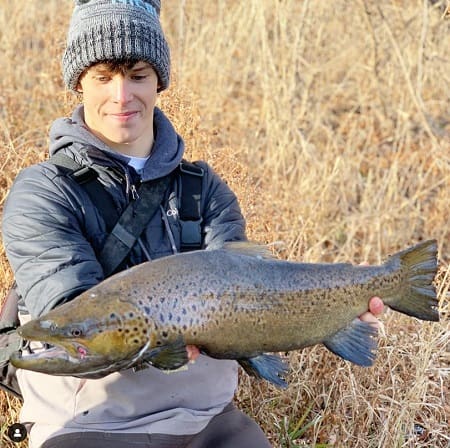
Some brown trout will start to show up in the river as early as September, as proven by the current brown trout record, which was caught on September 9th.
These large migratory browns could be following salmon and steelhead into the rivers to feed on eggs, or they could be just getting the urge to find their spawning grounds.
Larger numbers of brown trout will start entering the rivers in October and early November, and they will spawn in Late October, November, and Early December.
It is best to fish for big brown trout when they are moving up the river to their spawning grounds, or after they spawn when they are holding or slowly dropping back to the lake. I recommend avoiding fishing for brown trout that are on the spawning beds.
Once the brown trout finish spawning, most of them will migrate back to the lake.
However, some brown trout that spawn later in November and December have been known to hold over in the deeper slower pools throughout the winter. Some will slowly drop back with higher water over the winter, while some will say until the spring.
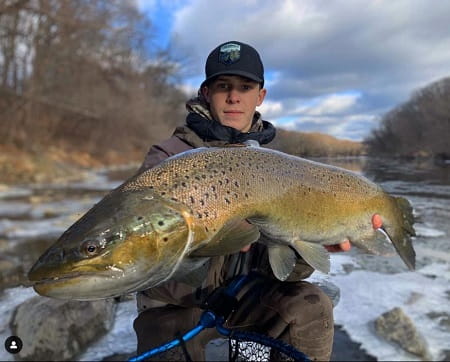
This allows anglers to catch lake-run browns all winter and into late spring with little fishing pressure.
The best times for winter and spring are on warmer days in the lower parts of the river and the bigger pools.
As seen in the above picture, the ice around Matthew shows that big brown trout can be caught throughout the winter.
I have caught plenty of big browns in February and March while fishing for spring steelhead, but my best time to catch big migratory browns is usually mid-December just before the rivers freeze.
Methods For Catching These Big Brown Trout
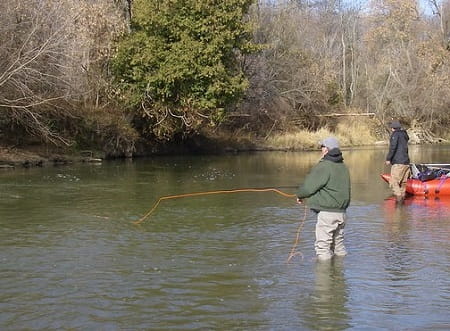
Anglers will use multiple tactics such as fly fishing, float fishing, and casting lures to catch these big brown trout when they enter the rivers to spawn, and lake anglers will cast lures or baits off the piers, at river mouths, harbors, and inlets, and shorelines all around the Great Lakes region.
Boat anglers can target the huge brown trout out in the lakes all season using mostly trolling methods.
I will discuss each method in more detail below as well as the best baits and lures.
Near Shore Fishing
One of the great things about brown trout preferring 60 to 63-degree water temperatures is that they are often higher in the water column than steelhead and salmon, and they are often closer to shore, which is great for shore anglers.
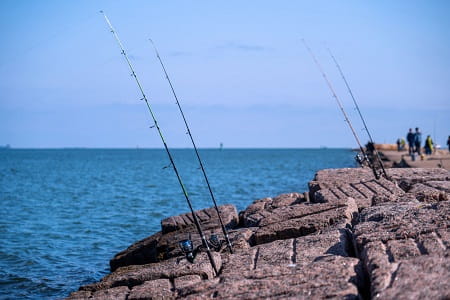
Near-shore waters where anglers will target them the most will be in river inlets, shorelines on either side of the river mouths, harbors, marinas, bays, and near warm water discharges from power plant facilities.
In fact, these warm water outflows have a warmer water temperature in the winter months than the lake and this is like a magnet that attracts a lot of fish, including baitfish, and these areas can be some of the best brown trout fishing anywhere on the lake.
Brown trout are known to move in close to shores to feed on baitfish that are pushed into shore by winds and currents. In my area, anglers will fish for big browns in marinas that are near known brown trout rivers.
The outflows of the rivers can be excellent areas to try for big browns, especially if the water temperatures are ideal.
Methods For Shore Fishing For Brown Trout
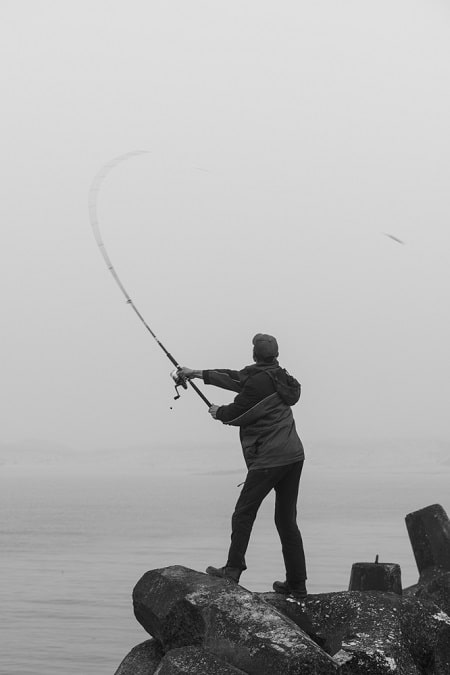
Anglers on shore will do well casting spoons and spinners in the early morning and evening times.
Spoons: Spoons like Little Cleos and Krocodiles work well because they are heavy, can be cast a long way out, and have a good wobble.
Spinners: Spinners like Mepps, Panther Martins, and Blue Fox Vibrax in sizes 3 to 5 can be very effective on lake browns.
Crankbaits: If brown trout are in close enough, crankbaits can also be very effective baits, and at times, they can’t be beat.
4 to 7-inch crankbaits like Rapalas, Coton Cordels, and Live Targets are good options. The same lures used by steelhead anglers work great for brown trout. See Best Steelhead Lures.
Lure Colors: Silver and color combinations like silver/green, silver/blue, and silver/orange can be consistent producers.
Brown trout will eat the same lures that steelhead will.
Bait Fishing: Some anglers will also do well with baits like spawn bags, live minnows, salted minnows, and maybe even worms. Normally, anglers will surf cast using the plunking method the same way steelhead and salmon anglers would.
Tackle: Seven to nine-foot spinning rods are best for casting lures. Spinning reels with mono lines are used the most often, but braided lines with a short fluorocarbon leader are good, too.
Boat Fishing For Brown Trout
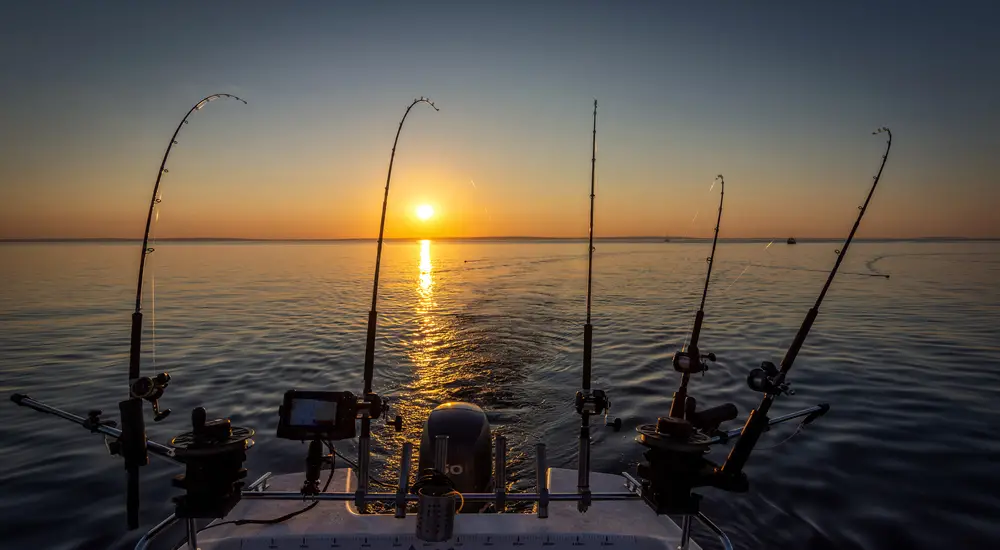
Some anglers will specifically target big brown trout out in the lake but often, the brown trout that get caught in the deep water of the lake are usually incidental catches by salmon and steelhead anglers.
Anglers looking to target browns will often stay closer to shore and fish deep water and shallow water where there are concentrations of baitfish. The primary baitfish is Alewife which will concentrate near shore in the spring months when they spawn.
The best areas include river outlets, inlets, and warm water discharges. The brown trout feeding in these warmer areas will be more aggressive than out in the deeper cold water of the lake.
Fishing near feeder creeks and the mouth of large rivers in the early spring can be most productive.
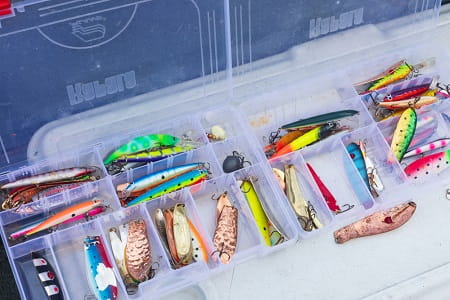
When fishing from a boat, anglers will troll spoons, plugs, and crankbaits.
Anglers will sometimes flatline out the back of the boat, use planner boards, and if the browns are holding deep they will use Dipsy Divers, lead-core lines, and downriggers to get the right depth.
The depth you want to run your lure at will depend on many factors, which include where the baitfish are, time of day, time of year, and water temperatures. The conditions will dictate where the browns will be feeding.
In August and throughout the summer, anglers will often troll the deeper water. Summer fishing can be the most challenging since the browns will often be further out in the lake feeding on Alewife or spread out.
As summer comes to an end, brown trout will start moving closer to shores and rivers, and so should you. Often the End of August will see browns concentrating closer to shore and hanging around current flows from the rivers they intend to run up to spawn.
This is when fishing from shore or fishing from a boat can start to get good.
By late November, a lot of the spawning brown trout will start returning and entering the lake. This is when anglers should troll near the river mouths.
Tackle: Most anglers use 7 to 9-foot trolling rods or downrigger rods rigged trolling reels with mono lines on them.
River Fishing For Lake Run Brown Trout
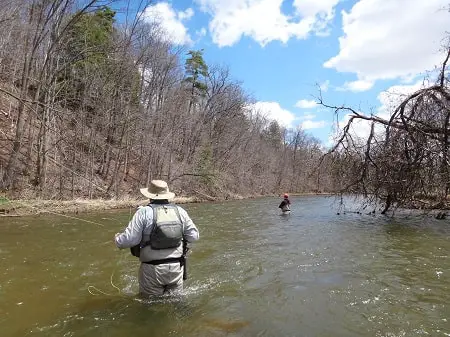
Most anglers will target lake-run brown trout in the rivers when they return to spawn.
It’s not uncommon to catch brown trout in the rivers from the end of September to the end of March.
Understanding their river migrations will greatly improve your odds of connecting with one of these trophies. Higher river flows from rain will often trigger the big runs. Once the river clears and drops, the fishing for browns can be great.
Just about any Great Lakes tributaries that get runs of steelhead or salmon could also have runs of browns.
While you are fishing for brown trout in the early season, you can also take advantage of the great Salmon fishing since the browns and salmon will hit the same baits and lures.
Later in the fall, there will be a lot more brown trout in the river and a lot more steelhead in the rivers. The good thing with that is the steelhead fishing methods are the same.
Where In The River To Fish For Lake-Run Brown Trout?
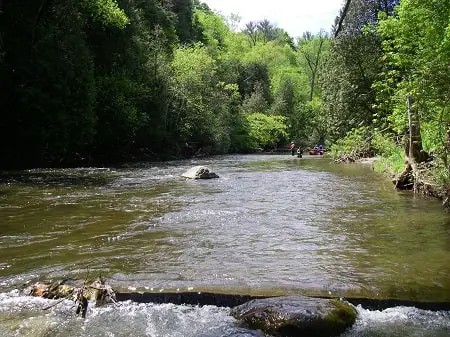
Brown trout in the river will use the same areas as steelhead and salmon. Even 20-pound brown trout can be in shallow water that’s only 2 feet deep.
Depending on the conditions, you will find brown trout in the pools, shallow and deeper runs, pockets, and amongst large rocks, log jams, and below rapids or obstructions like the log and rock in the above image.
You may need to try different depths to figure out where they are.
In warmer water, when they are running up the river they will be found in the middle of the pools and close to the head of the pool.
Holding water in high sun and mid-day or when the water is very cold they will be in the deeper water or in the slower tail-out of the pools.
Because of clear water, they will try to stay hidden, so anglers should look for deeper sections, especially on smaller rivers with clear water.
Sometimes it’s hard to find fish, so you may need to keep moving and try different types of water and many pools before you find fish that are willing to bite.
On larger waters, focus on bends or areas that narrow and concentrate fish. Areas like below rapids and damns can be great spots.
Lake Run Brown Trout Methods For Rivers
You can catch brown trout on all the same methods that anglers use for steelhead and salmon once they enter the rivers.
Spin Fishing
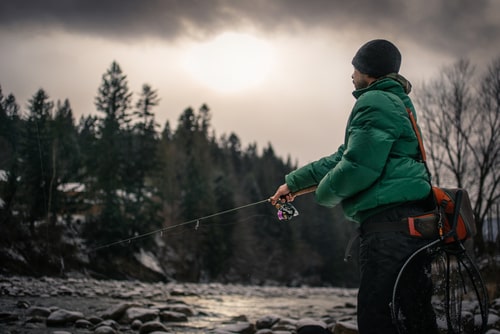
Spin fishing can be done with lures or baits and with many methods suitable for rivers.
Anglers can cast lures like spoons, spinners, and crankbaits. The same lures that will catch big steelhead will also catch these big browns. See Steelhead Lure Fishing.
Jig fishing from brown trout can also be fantastic, and since many anglers don’t use jigs it is well worth a try. I jig fish from brown the same way I jig fish for steelhead and for salmon.
Bait fishing methods can include float fishing, bottom bouncing, drift fishing, bobber dogging, and plunking.
Tackle: Seven to eight-foot rods are great for casting lures. Spinning reels or baitcasting reels with mono, fluorocarbon, or braids are used. For bait fishing, 8 to 13-foot rods are used with spinning reels, baitcasting reels, or, if you float fish then Centerpin reels.
Float Fishing For Great Lakes Browns
Float fishing might be the most effective way to catch big migratory browns, especially in slower deeper water or on very long pools. With float fishing, you simply drift your bait down the river under a float, aka a bobber.
The float fishing methods for brown trout are the same as float fishing for Steelhead.
Float fishing with 11 to 13-foot rods is best. These long rods help you control your presentation. Anglers use spinning reels, baitcasting reels, or the best is to use a centerpin reel.
Float fishing will work in fast and slow flows.
Centerpin Fishing For Great Lakes Browns
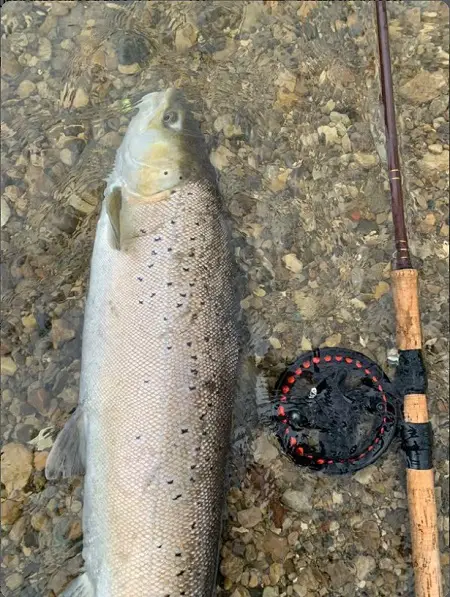
If you are going to do float fishing for Great Lakes browns, in my opinion, the most effective way to float fish is with a centerpin reel. This is known as centerpin fishing.
With centerpin fishing, you can control the speed of the float much more effectively compared to a spinning reel or a baitcasting reel.
Controlling your presentation and speed will help trigger more bites, even from less active fish.
For this reason, Centerpin fishing might be the fasting growing method for migratory browns, steelhead, and salmon.
Learn more about Centerpin fishing at Centerpin Fishing: Guides Explain
Fly Fishing
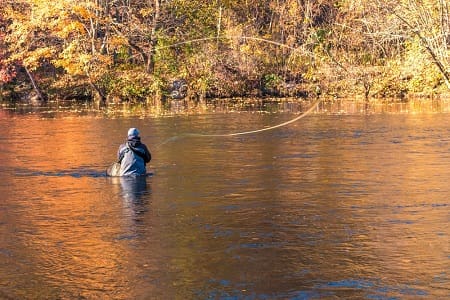
If you look at the many river guides around the Great Lakes offering guide trips for migratory browns, steelhead, and salmon, most of them prefer fly fishing.
I prefer fly fishing for them too, simply because it’s fun, challenging, and can be very effective. I use the same four fly fishing tactics, lines, rods, and flies that I use for steelhead.
Brown trout, whether migratory or not, love flies even though they are not as focused on insects as other trout might be. Even in tough conditions or when the browns are being pressured by lots of anglers, small nymphs can be the best bet.
Nymph patterns like Stoneflies, and mayfly nymphs like a pheasant Tail Nymph, as well as Woolly Buggers, and Egg-sucking Leeches can be hard for brown trout to resist.
Egg fly patterns can also be deadly. The same patterns that are good for steelhead are also good for brown trout. See 19 Best Steelhead Flies.
Eggs in yellow, white, and light oranges can be great.
Most anglers and guides use a floating fly line on single-hand fly rods and they mostly use the indicator fishing method. I use the same fly rod setup that I use for steelhead
Indicator fishing is when you suspend your nymphs below a micro float known as an indicator. Use a good leader setup with just enough weight to get your flies down. I use the exact same nymphing leader setup for steelhead and salmon.
I prefer to use Euro Nymphing in fast water, pocket water, and any pool under 6 feet deep. Add weight to your nymphing rig as needed to get your flies just off the bottom.
Often the rivers will be clear so a light tippet of 6 or 8 pounds is required for most nymphing. A fluorocarbon tippet is best since it’s practically invisible to the fish and has good abrasion resistance.
A switch rod can also be used for both indicator fishing and for stripping flies or swinging flies.
Streamer fishing is done the same way as when steelhead fishing. Streamer patterns and Spey patterns used by steelhead anglers will be productive. Some of my favorites are the Hobo Spey, bunny leech, muddler minnow, and zoo cougar.
Productive colors include black, olive, white, and yellow. If your streamer has some flash even better.
If you want to use streamers and Spey flies use a heavier fluorocarbon tippet of 12 pounds.
You will find earlier in the fall until about late November when the water is still slightly warmer will be the best time to catch brown on streamers. In late fall and winter, when the water is much colder, slow presentations like nymphing will be much more productive.
Some anglers will also target browns at the river mouth and near shore waters with streamers. Use a fluorocarbon tippet of about 12 pounds for this type of fishing.
Best Baits For Great Lakes Browns
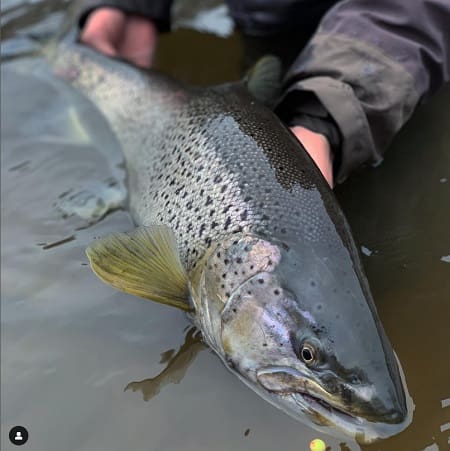
Active brown trout are opportunistic and will eat just about any bait. I’ve even caught them on marshmallows and gummy bears trimmed to look like eggs.
However, I don’t recommend these baits since there are better baits that will work in all conditions.
The top baits include:
- Spawn sacs in natural colors such as yellow, orange, peach, pink, and white. In early fall, brighter colors will be best, but when the water gets ice cold white eggs are sometimes best.
- Live and plastic worms in natural brown, pink, and red
- Beads can be fantastic and I do well with natural colors such as orange, yellow, pink, peach, and white. Chartreuse can also be very good as seen in the above image.
- Flies are not just for fly fishermen. Flies can be fantastic on brown trout. Nymphs, egg patterns, and streamers like wooly buggers and egg-sucking leeches are usually good.
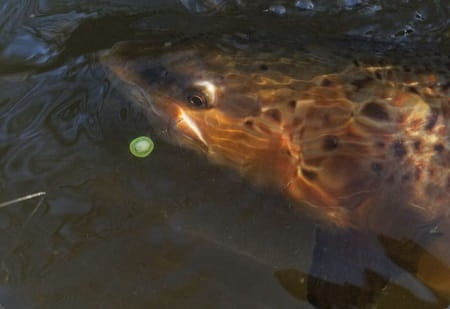
Beads and spawn bags are particularly good for brown trout in rivers. They are also great for salmon and steelhead. I use the same rigging and methods for all three species with good success and have been for over ten years.
See Bead Fishing For Steelhead for the proper rigging and methods used by guides.
Best Brown Trout Fishing Areas
There are some areas around the Great Lakes that stand out above the rest. These rivers are known for their great fall lake-run brown trout fishing but they can also get a bit busy.
I often prefer the smaller close-by tribs to these more popular rivers where there are fewer anglers but still plenty of brown trout. I like these rivers because sometimes, even though there are more brown trout in the popular rivers, they are harder to catch because of all the angler traffic that spooks them.
New York Rivers
There are a lot of bigger and smaller western new york rivers that can be very good and have good opportunities for larger fish.
Oak Orchard, 18-Mile Creek, are popular due to the large runs of brown trout.
Salmon River is heavily stocked and therefore, it can be fantastic fishing for brown from early fall to late spring, with an average size of 5 to 8 pounds.
The Niagara River is a brown trout meca and of the many rivers on this list, the mighty Niagara River might possibly be the best river.
Michigan Rivers
The Pere Marquette and the Big Manistee are two great rivers to consider if you are looking for a chance for larger fish.
Northern Michigan rivers also have opportunities for brown trout fishing and due to being further north, early fall can be when they will start showing up in the rivers.
Wisconsin Rivers
Sheboygan River, Oconto River, and Peshtigo River are Great Lakes tributaries that all have good opportunities for lake browns.
Tight Lines,
Graham

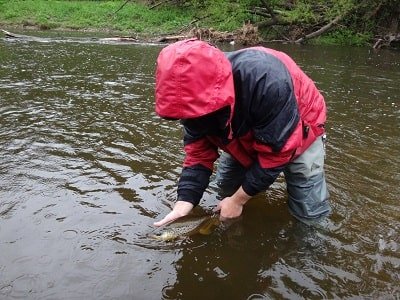
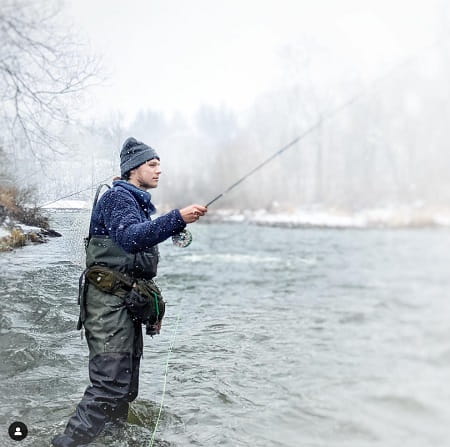
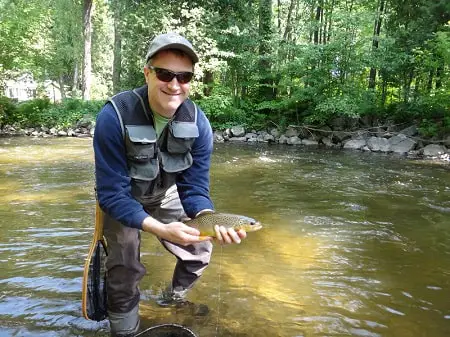
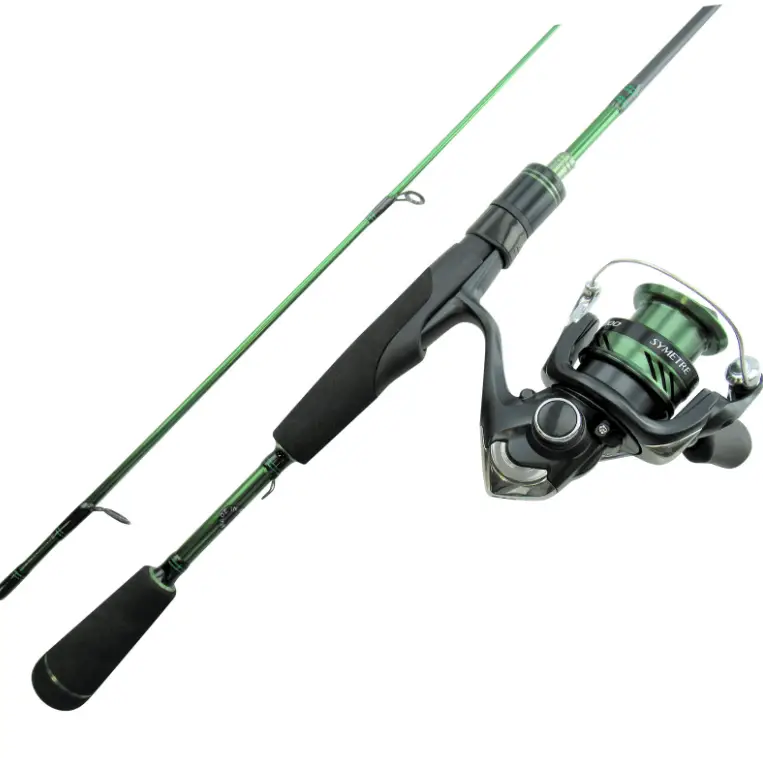
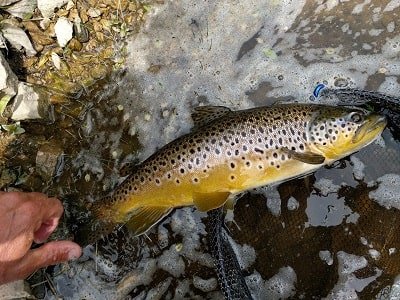
I would like to catch the brightly colored orange shade brown trout. What month would you recomend?
Hi Mark,
Later in the fall when the males are closer to the spawn they will take on those more orange darker shades. That’s the best time to try to achieve your goal.
Good luck,
Graham